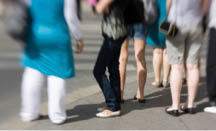 History and Presenting Symptoms
History and Presenting Symptoms
A 31-year-old male office worker reports a history of mild-to-moderate, intermittent lower back pain, along with an aching tightness in his neck. His back pain comes on with no specific triggering activities, and the neck tension is worse during long, stressful workdays. He is not involved in any recreational sports or exercise activities, and he doesn’t recall any back or neck injuries. On a 100mm Visual Analog Scale, he rates the low back pain as usually 35-45mm, and his neck tightness as around 25-30mm.
Exam Findings
Vitals. This man weighs 224 lbs, and is 5’9’’ tall. This calculates to a BMI of 33—he is obese. His waist measures 49 inches at the largest point above the ASIS, confirming abdominal obesity. His blood pressure is somewhat elevated at 144/90 mmHg, and his pulse rate is 80 bpm.
Posture and gait. Standing evaluation highlights the postural effects of abdominal obesity: a loss of lumbar curve, an accentuated thoracic kyphosis, and cervical anterior translation (forward head carriage). There is no noticeable lateral pelvic listing or lateral spinal curvature. He does have moderate bilateral knee valgus and bilateral calcaneal eversion, as well as collapsed medial arches. During gait evaluation, both feet flare outwards and exhibit excessive pronation.
Chiropractic evaluation. Motion palpation identifies several limitations in intersegmental spinal motion: the left SI joint, L4/L5 on the right, L2/L3 on the left, T11/12 generally and several levels at the cervicothoracic junction. There is no specific spinal tenderness or spasm of the paraspinal muscles, but adipose tissue is prevalent throughout. All active thoracic and lumbar ranges of motion are limited slightly by general stiffness. Neurological tests are negative for nerve root impingement, but straight leg raise is limited bilaterally by hamstring shortening and tightness.
Imaging
Upright, weight-bearing X-rays of the lumbar spine demonstrate loss of intervertebral disc height at L4/L5 and L5/S1, with moderate osteophyte formation at those levels. There is no discrepancy in femur head or iliac crest heights, and no lateral listing or lateral curvature. The sacral base angle and lumbar lordosis are both decreased, which is consistent with the postural analysis.
Clinical Impression
Chronic spinal stress syndrome due to obesity. This is emphasized by poor support from the lower extremities, with bilateral knee valgus, excessive pronation and calcaneal eversion.
Treatment Plan
Adjustments. Specific, corrective adjustments for the identified fixations were provided as needed, with good response. Specific manipulation of both feet and knees was also performed.
Support. Custom-made, flexible stabilizing orthotics were provided, to support weaknesses in the pedal foundation and decrease stress to the knees and back during walking. A custom-made cervical traction pillow was ordered, to provide proper alignment of the head, neck and shoulders during the night.
Rehabilitation. He was started on a localized spinal activation and strengthening program using elastic resistance tubing for the multifidus muscles—first in extension, then into rotation and lateral flexion. In addition, he was counseled on building up to 60 minutes a day of moderate physical activity for weight loss. He chose to walk for 15 minutes during lunchtime and another 15 minutes prior to his evening meal. After three weeks he doubled his time at each session. He used an exercise log as part of his motivation for sustaining his fitness activities, which included a healthy and balanced diet program.
Response to Care
He tolerated adjustments well, and adapted to the orthotics and cervical support pillow without difficulty. Low back symptoms resolved rapidly and, shortly thereafter, his neck tightness disappeared. His brisk walking program did not irritate his back, even after he increased to a total of 60 minutes daily. After six weeks of adjustments (8 visits), he was released to a self-directed home stretching program, with instructions to continue his exercise and healthy dieting.
Discussion
Obesity is still on the rise in all industrialized countries, since so many of us—like this case study—now live primarily sedentary lives. Additional, unhealthy pounds place increased stress on the lower extremities and spine, resulting in chronic symptoms and accelerating degenerative changes. Specific spinal adjustments and custom, postural support need to be combined with individualized dietary and exercise instructions for best results. An exercise/dietary log can improve patient adherence to recommended lifestyle changes.
